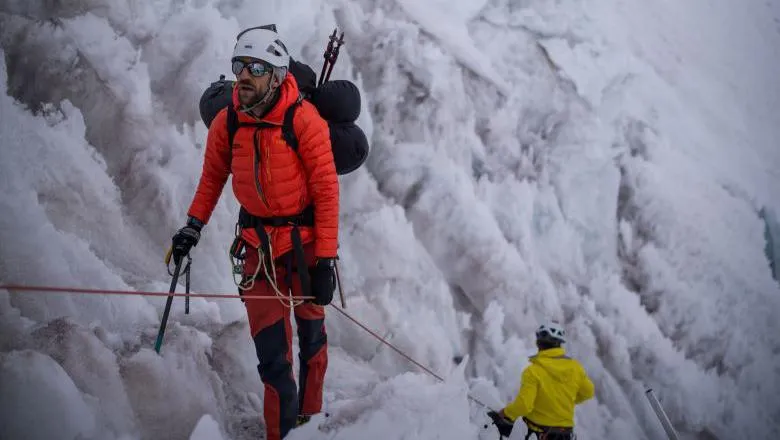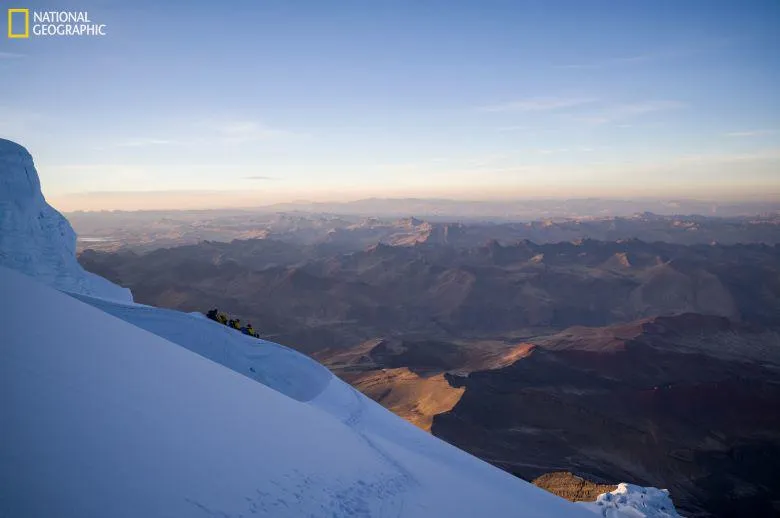There is a coupling, a relationship, between the Amazon and the Andes. It’s a really important cycle. If the Amazon wasn’t here as it is, the rainforest acting as it is to pump water from the Atlantic westward, we likely wouldn’t have these glaciers. What happens in the Amazon is an important control on environmental change elsewhere: in the Andes, and far beyond, too. So what happens in the Amazon influences the global climate.
Dr Tom Matthews
07 October 2024
National Geographic and Disney Plus role for intrepid Geography lecturer
New documentary focuses on 2022 expedition to install the highest weather station in the tropical Andes, jointly led by climate scientist Dr Tom Matthews

A senior lecturer in Geography is set to star in a new documentary about an expedition he jointly led to the headwaters of the Amazon and the summit of one of the highest peaks in the Andes.
Dr Tom Matthews – seen at the very start of the trailer below - braved the hazardous climb to the almost 6,500 m summit of Nevado Ausangate in southern Peru to install a weather station.
Along with fellow National Geographic Explorer Baker Perry, a local team of Peruvian scientists mountaineers and porters, and the female Bolivian climbing experts “the Cholitas Escaladoras'' the expedition represented an ambitious attempt to perform much needed high-altitude scientific research.
Their goal was to obtain meteorological data from one of the highest points in the Amazon watershed, and gather black carbon - residual ash from either wildfires or the nearby city of Cusco - and ‘snow water equivalent’ samples.
These samples are to improve understanding of climate change impacts in the upper Andes, an important freshwater source for Andean and downstream ecosystems.
Nevado Ausangate sits close to Quelccaya, the second-largest tropical ice cap in the world – one that is retreating fast due to global warming.
The Amazonian water cycle begins on peaks like Nevado Ausangate’s, says Dr Matthews, where melting ice starts water cascading towards the Atlantic, flowing through the mighty Amazon River on its way.
Easterly winds then carry water evaporated initially from the ocean – and then from the Amazonian trees themselves – back to the frozen upper Andes, where it falls as snow, ready for another lap through the greatest river system on Earth.
Whilst the connection between the Amazon and Andes is known in principle, the details have remained unclear because there is very little weather data from the high Andes due to the severe logistical challenges of installing monitoring equipment there.
Scientists lack a detailed picture from on the ground of how the highest-altitude snowpack and glaciers are responding to warming temperatures.
The weather station installed by the National Geographic team enables new insights into the conditions at one of the highest points in the Amazon basin. Its data will be of wide use for the international scientific community, and may help local decision making related to water resource management.
"The Nevado Ausangate is the source of life that we have for this region of Cusco," said Santos Huaman, Mayor of Chilca, the Peruvian township encompassing much of the Ausangate Valley. “This new weather station will help us to understand how much snow is melting, why, and how we recover it. It’s extremely important to our community.”

The expedition team also conducted in-situ monitoring of the atmosphere and analyzed snow-pack properties, obtaining direct measurements of ‘snow water equivalent’ from the snow-pack.
As part of the snow assessment, the team also collected samples to screen for microplastics in this remote and relatively pristine region.
They found them at all depths in the snow - indicating long term and long distance atmospheric transport - microplastics carried by winds from far away.
Sadly threatened and stunningly beautiful, the trip to the summit was not without dangers.
Getting to the top of Nevado Ausangate is no joke. It’s got longer stretches of verticality than Mount Everest. Ausangate is a mountain that’s not climbed that often.
Dr Tom Matthews
“Having local guides was absolutely critical,” he added.
The scientists turned to Quechuan and Aymara guides from Peru and Bolivia, as well as members of the Cholitas Escaladoras, Aymaran female mountaineers who climb in traditional dress.
The trip was part of the larger Perpetual Planet Amazon Expedition – a series of scientific research studies spanning the entire Amazon River Basin from the Andes to the Atlantic.
This work builds upon previous Perpetual Planet Expeditions to install weather stations in high mountain environments, including to Mt. Everest in 2019 and 2022, both of which were co- led by Dr Matthews.
The documentary Expedition Amazon can be seen in the UK from Sunday, October 13 on the National Geographic Channel (Sky, Virgin Media, BT, Talk Talk) as well as on Disney Plus.
You can read more about the expedition in the October edition of National Geographic magazine and see the incredible interactive story here.
All images © Justen Bruns/National Geographic taken during the National Geographic and Rolex Perpetual Planet Amazon Expedition.


